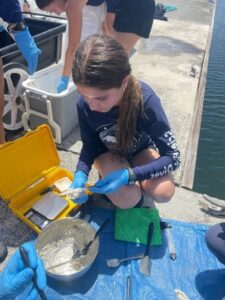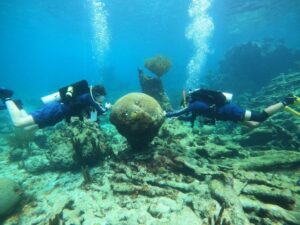Brain corals can grow to over six feet in diameter. I saw this for myself treating diseased coral in St. Croix this summer.
The trip started at two in the morning at the airport where we made our way to the U.S. Virgin Islands. We arrived at Camp Howard where we stayed for the week. The day after we dove at Frederiksted pier to gain our footing and make sure everyone was comfortable with the data collection methods we would be using throughout the week and become familiar with the dive site we would frequent later in the week.
This was my first ever SCUBAnauts trip or scientific diving mission. I went into this with no background knowledge on the scientific aspects of diving, so these dives helped me to learn different alga types and how to collect myself when doing so many different things while diving. At first, I found it difficult to do so many things at once and keep track of everything. I dropped my clipboard a couple times. After that first benthic dive, I started to get the hang of it. There are things I will remember to pack for my next trip like extra clips to clip things to my BC.
Coral Disease Treatment with the National Park Service
We averaged 2-3 dives a day, each one having a specific goal whether it was benthic or fish surveys. My favorite days of the trip were the two days we spent with the national park service treating diseased corals. We focused on brain corals with white band disease. Before making our way to the dive sites, we mixed up the treatment. It was a mixture of amoxicillin and a patented paste that releases the amoxicillin over the course of three days.
The first dive site I went to with NPS was “brain garden” and the second one was “boat cut.” Our NPS guide Rachel pointed out the first diseased coral to show us what the disease looked like and how to treat it. The coral she demonstrated on was by far the biggest brain coral I’ve ever seen in my life, and this dive site had the most I’ve ever seen in one place, it was insane!
Each buddy team went out with two syringes and a camera to take a picture of the coral we treated. There were a few challenges; the paste was sticky and would stick to our hands sometimes instead of the coral. It also got very shallow in some areas, and it was hard to treat the coral and stay in one spot because at times we would basically be snorkeling, and the waves would be pushing us around.
The main challenge was treating the right corals. There are other coral diseases like black band disease and bleaching that can look very similar to white band disease. I learned that the main way to differentiate bleaching and white band disease is that the band Is much more striking, where bleaching is more of a gradient. By the end of both dives I can say I can confidently identify white band disease.
Staghorn Coral Monitoring
We also did a snorkel on the last day with Dr. Williams from Mote Marine Laboratory, who is doing a project in St. Croix where we monitored the condition of the local staghorn coral. We were given a little presentation beforehand to identify some of the markings and diseases then we were sent out with our clipboards to measure and record the health of the coral. The conditions were pretty rough to say the least, so we only snorkeled 30 out of our 60-minute plan, but I still learned a lot.
I learned so much! Before going on this trip, I understood that some of the coral I was seeing wasn’t healthy, but now I could tell you specifically what’s going on with it. I’m excited to see what comes next for me with SCUBAnauts!
— Izzy A., Naut-in-Training, Tampa Chapter



